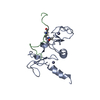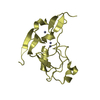+ Open data
Open data
- Basic information
Basic information
| Entry | Database: PDB / ID: 6xmn | ||||||
|---|---|---|---|---|---|---|---|
| Title | Solution NMR CXCL8-CXCR1 N-domain complex structure | ||||||
 Components Components |
| ||||||
 Keywords Keywords |  CYTOKINE / CYTOKINE /  Chemokine / CXCL8 / Chemokine / CXCL8 /  CXCR1 / CXCL8-CXCR1 N-domain complex CXCR1 / CXCL8-CXCR1 N-domain complex | ||||||
| Function / homology |  Function and homology information Function and homology information interleukin-8 receptor activity / regulation of single stranded viral RNA replication via double stranded DNA intermediate / regulation of entry of bacterium into host cell / interleukin-8 receptor activity / regulation of single stranded viral RNA replication via double stranded DNA intermediate / regulation of entry of bacterium into host cell /  interleukin-8 receptor binding / interleukin-8 receptor binding /  interleukin-8 binding / positive regulation of cellular biosynthetic process / interleukin-8 binding / positive regulation of cellular biosynthetic process /  chemokine receptor activity / negative regulation of cell adhesion molecule production / negative regulation of G protein-coupled receptor signaling pathway / ATF4 activates genes in response to endoplasmic reticulum stress ... chemokine receptor activity / negative regulation of cell adhesion molecule production / negative regulation of G protein-coupled receptor signaling pathway / ATF4 activates genes in response to endoplasmic reticulum stress ... interleukin-8 receptor activity / regulation of single stranded viral RNA replication via double stranded DNA intermediate / regulation of entry of bacterium into host cell / interleukin-8 receptor activity / regulation of single stranded viral RNA replication via double stranded DNA intermediate / regulation of entry of bacterium into host cell /  interleukin-8 receptor binding / interleukin-8 receptor binding /  interleukin-8 binding / positive regulation of cellular biosynthetic process / interleukin-8 binding / positive regulation of cellular biosynthetic process /  chemokine receptor activity / negative regulation of cell adhesion molecule production / negative regulation of G protein-coupled receptor signaling pathway / ATF4 activates genes in response to endoplasmic reticulum stress / CXCR chemokine receptor binding / C-C chemokine receptor activity / embryonic digestive tract development / chemokine receptor activity / negative regulation of cell adhesion molecule production / negative regulation of G protein-coupled receptor signaling pathway / ATF4 activates genes in response to endoplasmic reticulum stress / CXCR chemokine receptor binding / C-C chemokine receptor activity / embryonic digestive tract development /  neutrophil activation / C-C chemokine binding / induction of positive chemotaxis / cellular response to fibroblast growth factor stimulus / chemokine-mediated signaling pathway / positive regulation of neutrophil chemotaxis / Chemokine receptors bind chemokines / neutrophil activation / C-C chemokine binding / induction of positive chemotaxis / cellular response to fibroblast growth factor stimulus / chemokine-mediated signaling pathway / positive regulation of neutrophil chemotaxis / Chemokine receptors bind chemokines /  chemokine activity / dendritic cell chemotaxis / Interleukin-10 signaling / cellular response to interleukin-1 / chemokine activity / dendritic cell chemotaxis / Interleukin-10 signaling / cellular response to interleukin-1 /  regulation of cell adhesion / response to endoplasmic reticulum stress / Peptide ligand-binding receptors / regulation of cell adhesion / response to endoplasmic reticulum stress / Peptide ligand-binding receptors /  neutrophil chemotaxis / secretory granule membrane / G protein-coupled receptor activity / calcium-mediated signaling / response to molecule of bacterial origin / neutrophil chemotaxis / secretory granule membrane / G protein-coupled receptor activity / calcium-mediated signaling / response to molecule of bacterial origin /  receptor internalization / positive regulation of angiogenesis / receptor internalization / positive regulation of angiogenesis /  chemotaxis / antimicrobial humoral immune response mediated by antimicrobial peptide / chemotaxis / antimicrobial humoral immune response mediated by antimicrobial peptide /  heparin binding / cellular response to tumor necrosis factor / positive regulation of cytosolic calcium ion concentration / G alpha (i) signalling events / Senescence-Associated Secretory Phenotype (SASP) / heparin binding / cellular response to tumor necrosis factor / positive regulation of cytosolic calcium ion concentration / G alpha (i) signalling events / Senescence-Associated Secretory Phenotype (SASP) /  angiogenesis / Interleukin-4 and Interleukin-13 signaling / cellular response to lipopolysaccharide / cell surface receptor signaling pathway / intracellular signal transduction / angiogenesis / Interleukin-4 and Interleukin-13 signaling / cellular response to lipopolysaccharide / cell surface receptor signaling pathway / intracellular signal transduction /  immune response / immune response /  inflammatory response / G protein-coupled receptor signaling pathway / negative regulation of cell population proliferation / external side of plasma membrane / negative regulation of gene expression / Neutrophil degranulation / positive regulation of gene expression / inflammatory response / G protein-coupled receptor signaling pathway / negative regulation of cell population proliferation / external side of plasma membrane / negative regulation of gene expression / Neutrophil degranulation / positive regulation of gene expression /  signal transduction / signal transduction /  extracellular space / extracellular region / extracellular space / extracellular region /  plasma membrane plasma membraneSimilarity search - Function | ||||||
| Biological species |   Homo sapiens (human) Homo sapiens (human) | ||||||
| Method |  SOLUTION NMR / SOLUTION NMR /  simulated annealing simulated annealing | ||||||
 Authors Authors | Sepuru, K.M. / Rajarathnam, K. | ||||||
| Funding support |  United States, 1items United States, 1items
| ||||||
 Citation Citation |  Journal: To Be Published Journal: To Be PublishedTitle: Solution NMR CXCL8-CXCR1 N-domain complex structure Authors: Sepuru, K.M. / Rajarathnam, K. | ||||||
| History |
|
- Structure visualization
Structure visualization
| Structure viewer | Molecule:  Molmil Molmil Jmol/JSmol Jmol/JSmol |
|---|
- Downloads & links
Downloads & links
- Download
Download
| PDBx/mmCIF format |  6xmn.cif.gz 6xmn.cif.gz | 662.2 KB | Display |  PDBx/mmCIF format PDBx/mmCIF format |
|---|---|---|---|---|
| PDB format |  pdb6xmn.ent.gz pdb6xmn.ent.gz | 579.9 KB | Display |  PDB format PDB format |
| PDBx/mmJSON format |  6xmn.json.gz 6xmn.json.gz | Tree view |  PDBx/mmJSON format PDBx/mmJSON format | |
| Others |  Other downloads Other downloads |
-Validation report
| Arichive directory |  https://data.pdbj.org/pub/pdb/validation_reports/xm/6xmn https://data.pdbj.org/pub/pdb/validation_reports/xm/6xmn ftp://data.pdbj.org/pub/pdb/validation_reports/xm/6xmn ftp://data.pdbj.org/pub/pdb/validation_reports/xm/6xmn | HTTPS FTP |
|---|
-Related structure data
| Similar structure data | |
|---|---|
| Other databases |
|
- Links
Links
- Assembly
Assembly
| Deposited unit | 
| |||||||||
|---|---|---|---|---|---|---|---|---|---|---|
| 1 |
| |||||||||
| NMR ensembles |
|
- Components
Components
| #1: Protein |  Interleukin 8 / IL-8 / CXCL8 / C-X-C motif chemokine 8 / Chemokine (C-X-C motif) ligand 8 / Emoctakin / Granulocyte ...IL-8 / CXCL8 / C-X-C motif chemokine 8 / Chemokine (C-X-C motif) ligand 8 / Emoctakin / Granulocyte chemotactic protein 1 / GCP-1 / Monocyte-derived neutrophil chemotactic factor / MDNCF / Monocyte-derived neutrophil-activating peptide / MONAP / Neutrophil-activating protein 1 / NAP-1 / Protein 3-10C / T-cell chemotactic factor Interleukin 8 / IL-8 / CXCL8 / C-X-C motif chemokine 8 / Chemokine (C-X-C motif) ligand 8 / Emoctakin / Granulocyte ...IL-8 / CXCL8 / C-X-C motif chemokine 8 / Chemokine (C-X-C motif) ligand 8 / Emoctakin / Granulocyte chemotactic protein 1 / GCP-1 / Monocyte-derived neutrophil chemotactic factor / MDNCF / Monocyte-derived neutrophil-activating peptide / MONAP / Neutrophil-activating protein 1 / NAP-1 / Protein 3-10C / T-cell chemotactic factorMass: 7714.061 Da / Num. of mol.: 1 / Fragment: residues 28-93 Source method: isolated from a genetically manipulated source Source: (gene. exp.)   Homo sapiens (human) / Gene: CXCL8, IL8 / Plasmid: pET32 Xa/LIC / Production host: Homo sapiens (human) / Gene: CXCL8, IL8 / Plasmid: pET32 Xa/LIC / Production host:   Escherichia coli BL21 (bacteria) / Strain (production host): BL21 / References: UniProt: P10145 Escherichia coli BL21 (bacteria) / Strain (production host): BL21 / References: UniProt: P10145 |
|---|---|
| #2: Protein/peptide | Mass: 3350.576 Da / Num. of mol.: 1 / Fragment: N-terminal residues 1-29 Source method: isolated from a genetically manipulated source Source: (gene. exp.)   Homo sapiens (human) / Gene: CXCR1, CMKAR1, IL8RA / Plasmid: pET32 Xa/LIC / Production host: Homo sapiens (human) / Gene: CXCR1, CMKAR1, IL8RA / Plasmid: pET32 Xa/LIC / Production host:   Escherichia coli BL21(DE3) (bacteria) / Strain (production host): BL21(DE3) / References: UniProt: P25024 Escherichia coli BL21(DE3) (bacteria) / Strain (production host): BL21(DE3) / References: UniProt: P25024 |
-Experimental details
-Experiment
| Experiment | Method:  SOLUTION NMR SOLUTION NMR | ||||||||||||||||||||||||||||||||||||||||||||||||||||||||||||||||||||||||||||||||||||||||||||||||||||||||||||||||||||||||||||||
|---|---|---|---|---|---|---|---|---|---|---|---|---|---|---|---|---|---|---|---|---|---|---|---|---|---|---|---|---|---|---|---|---|---|---|---|---|---|---|---|---|---|---|---|---|---|---|---|---|---|---|---|---|---|---|---|---|---|---|---|---|---|---|---|---|---|---|---|---|---|---|---|---|---|---|---|---|---|---|---|---|---|---|---|---|---|---|---|---|---|---|---|---|---|---|---|---|---|---|---|---|---|---|---|---|---|---|---|---|---|---|---|---|---|---|---|---|---|---|---|---|---|---|---|---|---|---|---|
| NMR experiment |
|
- Sample preparation
Sample preparation
| Details |
| ||||||||||||||||||||||||||||||||||||||||||||
|---|---|---|---|---|---|---|---|---|---|---|---|---|---|---|---|---|---|---|---|---|---|---|---|---|---|---|---|---|---|---|---|---|---|---|---|---|---|---|---|---|---|---|---|---|---|
| Sample |
| ||||||||||||||||||||||||||||||||||||||||||||
| Sample conditions | Details: CXCL8-CXCR1 complex sample Labeled CXCL8 mixed with unlabeled CXCR1 N-domain Ionic strength: 50 mM / Label: CXCL8-CXCR1_complex_sample_1 / pH: 6.0 / Pressure: 1 bar / Temperature: 303 K |
-NMR measurement
| NMR spectrometer |
|
|---|
- Processing
Processing
| NMR software |
| ||||||||||||||||||
|---|---|---|---|---|---|---|---|---|---|---|---|---|---|---|---|---|---|---|---|
| Refinement | Method:  simulated annealing / Software ordinal: 2 simulated annealing / Software ordinal: 2 | ||||||||||||||||||
| NMR representative | Selection criteria: closest to the average | ||||||||||||||||||
| NMR ensemble | Conformer selection criteria: structures with the lowest energy Conformers calculated total number: 30 / Conformers submitted total number: 20 |
 Movie
Movie Controller
Controller












 PDBj
PDBj













